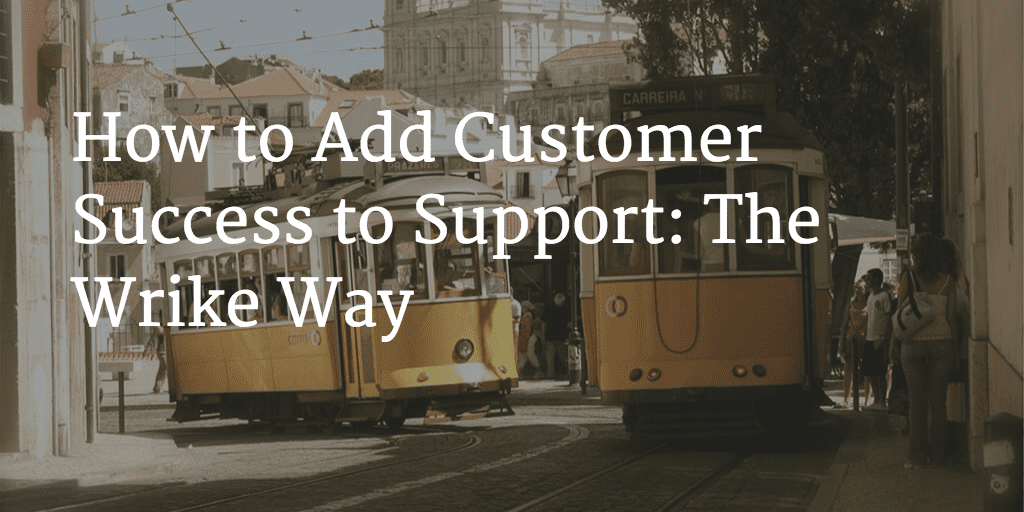Dan had some great comments in his post on Nov. 5 about “Aligning Customer Success and Customer Support.” However, there’s something to be said for many companies who have built a traditional sales/support organizational structure without Customer Success in the original plan. So how does a company get from the traditional Sales & Support model to one with added Success?! Let’s start with a bit of backstory on Wrike, and I’ll explain how we did this in incremental steps.
At Wrike, we started our customer service department as the basic all-encompassing customer support for break/fix as well as how-to questions from any and all customers. If a customer had a question, then we were there to answer. Over time it has evolved to email, live chat, and phone support, 24/7 for our thousands of customers around the world. And it works great! Customers sometimes even tell us they’re choosing our product over our competitors because of our great customer support. That said, when the reactive Customer Support team was the only team, then it meant we were missing opportunities to proactively reach customers who needed our help for the exact situations that Dan specified: the champion leaves the company, low usage, etc.
So Wrike was at a cross-roads where we had thousands of customers and a great Customer Support organization, but no proactive Customer Success team. Do we hire 10 Customer Success people all at once in order to ramp up and cover each and every customer? Would the additional work done by the Customer Success team to proactively work with accounts decrease the Customer Support load – if so, does it make sense to reassign some people on the Customer Support team to Customer Success?
We took a measured approach and hired one Customer Success person to start, and we chose to focus on each Customer Success function individually. Our first goal was to tackle better on-boarding. Each new customer was introduced to and received an email from Customer Success with on-boarding tips as well as one-on-one training sessions. As expected, it worked great!
Next, we tackled at-risk customers with low activity. We called these customers to find out why their activity was low and looked to find trends where we could develop an action plan. This way in the future when we spot these same trends with new customers, we can catch it early and respond accordingly. Implementing one piece at a time allowed us to build the team slowly and methodically, making sure we were making a real impact on the customers with each additional team member and each additional Customer Success function.
It’s much the same way that you might implement a Customer Success tool like Gainsight – one piece at a time. In the beginning, it’s not an overwhelming process of having to send every single data point into the system and implement every possible trigger. It would be an overwhelming amount of data to start with and would take too long to do all at once, and with no ROI while the work is being done. Another analogy might be similar to building a new software product – you need to define your minimum viable product specifications in order to be able to launch version 1.0, and then build and iterate from there. And so it was the same with our building of the Customer Success team at Wrike – incremental steps to realize real value and ROI for the effort being done.
Another place to start might be to add Customer Success only for your premier or enterprise accounts. It’s an easy way to implement the Customer Success function for the most valuable customers first as there are fewer of them and they of course have a much bigger impact on revenue. Based on the success of the team at the premier/enterprise level, you can then find ways to mirror those efforts on a larger scale for the smaller customers through mass webinars, automated email follow-up based on specific triggers, and other things which allow Customer Success efforts to be more successful with a larger group of customers per rep.
I completely agree with Dan’s mention of the grey area between the two teams. Case-in-point: 24/7 Customer Support. As customers have how-to questions, they likely don’t want to wait hours for their assigned Customer Success rep to reply (assuming each customer has an individually assigned rep). It’s important for customers to get answers fast. With the ubiquity of internet connectivity, people can work anytime and anywhere. I was working late last night (12am) preparing some reports for our monthly SLAs and had some questions about the reporting. Of course, I didn’t want to wait until the morning, but unfortunately I had to. So the value of “always on,” reactive Customer Support is definitely not diminished.
When you have established Customer Success and Customer Support teams, it’s easier to define their roles and maybe even tweak some of the activities and responsibilities of each team for the optimal mix in a particular business. Or if you build the Customer Success and Customer Support functions side by side from the start in a new startup company it might be easier to more clearly outline the separate roles. But I think many companies today are in “catch up” mode and trying to add Customer Success teams to an existing organizational structure, and for Wrike, the successful way to do it has been in incremental steps with measured wins.
